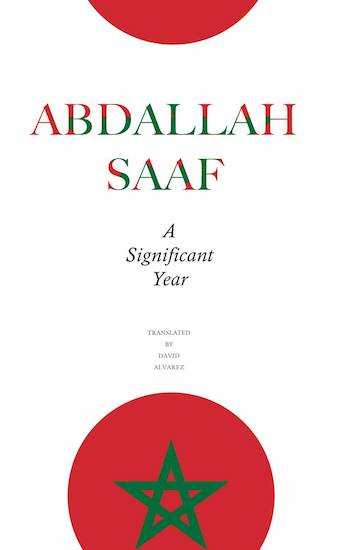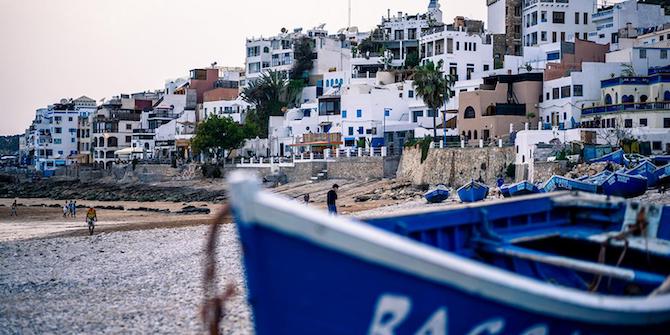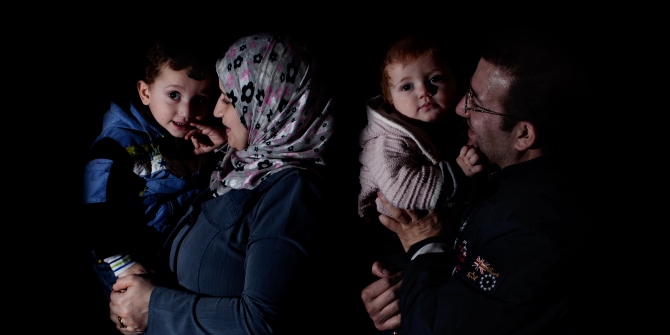by Khalid Lyamlahy
‘A road-trip is an indispensable way of getting to know one’s country better, of feeling its pulse’: the opening sentence of Moroccan writer and political scientist Abdallah Saaf’s A Significant Year, recently translated by David Alvarez, sets the stage and tone for the following pages. ‘Part travelogue, part sociological analysis and part political prognosis’, as Alvarez puts it, A Signifiant Year was written ahead of Morocco’s 2007 parliamentary elections and first published in French in 2012. The recent English translation is a slightly condensed version of the original book which charts Saaf’s road trips across various regions of Morocco during the summer of 2007. A modern reworking of the long tradition of Arabic travelogues known as rihla, A Significant Year seems a logical sequel to the author’s previous Carnets de bus (Bus Notebooks, 1999), which brought an astute literary and sociological sensibility to his daily bus journeys across Rabat. Now, Saaf’s routes are lengthier and the meditations cast more broadly. Morocco, through Saaf’s incisive, transient gaze, becomes the stage for an interdisciplinary investigation which seeks to match the complexity of the country’s own social and political realities.
*
As a professor of political sciences at Mohammed V University in Rabat and the Director of the Research Centre for Studies in Social Sciences (CRESS), Saaf is a respected and knowledgeable observer of Moroccan society and politics. His publications include historical novels as well as several essays and edited collections on questions of governance, reform, and democracy not only in Morocco but also in the Euro-Mediterranean context. But Saaf’s career is also grounded in many years of political activism and bureaucratic reform. A former activist in the Moroccan far left during the ‘Years of Lead’, a period of repressive and authoritarian rule usually dated back to the 1960s, Abdallah Saaf became a member of the ‘Organization of the Popular Democratic Action’ (OADP), a left-wing party founded in 1983 that took part in the ‘alternance’ coalition government led in 1998 by former opponent and socialist figure Abderrahman El Youssoufi. The latter’s death in May 2020 prompted an outpouring of local and international tributes. Saaf saw the legacies of the beloved Prime Minister as yet undervalued, writing in the Moroccan weekly Tel Quel that ‘history has yet to do justice to El Youssoufi.’ Under El Youssoufi, Saaf served first as the Deputy Minister of Secondary and Technical Education (1998-2000) and then as the Minister of Education (2000-2002), grappling with one of the most complex and pressing issues in the country. In 2011, in the aftermath of the so-called ‘Arab Spring’ that swept across the region, Saaf was elected as a member of the Commission entrusted with drafting proposals to revise the Constitution, the main outcomes of which consisted in slightly extending the power of the Prime Minister and recognising Tamazight (or Berber), alongside Arabic, as an official language of the country.
*
Unsurprisingly, then, Moroccan politics are at the core of Saaf’s travelogue with the 2007 elections serving as a common thread. Throughout his journey, which starts in the capital Rabat, Saaf wonders about ‘the centrality of the elections’ in people’s lives and questions the insufficient power of the Moroccan Parliament and its consequences. ‘Parliamentarians’, he writes, ‘are really no more than para-political actors’. In a country where the political scene is at once diverse and divided, political parties have failed both to attract and integrate citizens and also to renew their own elite, hampering any efforts to develop a global and sustainable vision for the country. Saaf systematically observes this limited interest in electoral activity: the slow and barely visible mobilisation of voters, the persistent recourse to ‘promises of largesse’ and ‘administrative favours’, the hazy selection of the candidates and the overvaluation of their executive power. Progressively assuming ‘the role of electoral observer’, Saaf laments Morocco’s lack of democratic practices, including political debates and polls. Saaf’s observations are acute and his critiques well-aimed. On the road to Agadir, for example, he wryly notes the acceleration of progress on public roadworks ‘as if miraculously speeded up during this period prior to the popular vote.’ As a political scientist, Saaf is also attentive to regional dynamics and transformations. In the northern city of Tetouan, he outlines ‘the upstaging of the Left by political Islamism’ and emphasises the progressively dominant role of the city’s notables and the Zawiyas or brotherhoods. But in Marrakech, he diagnoses the ‘increasing Americanisation of campaigning methods and means’ through the use of mass media. Ultimately, he concludes that ‘the culture of voting isn’t deeply anchored’ among Moroccan people and that the outcome of an election would be ‘to obliterate the complex experiences of history, to efface the past and to constrain political choices to whatever happens to be on sale at the moment.’
*
Saaf’s travelogue, however, is not only about the political analysis of the pre-elections period. In the prologue, Saaf even distances himself from the ‘world-view that deems elections a key to unlocking the mystery of the universe’ and prefers to define his project as an attempt ‘to take advantage of the present moment to better grasp the country’s deepest realities.’ And so the travelogue offers, beyond politics, a wide range of social and cultural insights. Saaf eloquently describes architectural and urban contradictions, renders ambiance and atmosphere, and identifies changes in infrastructure and state policies. This broad yet sharp descriptive effort often serves to introduce economic or social assessments. In the northern city of Nador, for instance, he observes that the repeated use of the name ‘Illias’ on storefronts ‘contributes to the construction of regional identity’. When leaving Fez, he writes that ‘the black smoke that the chimneys incessantly belch up is proof that the city suffers from a serious sickness’. For Saaf, appearances are never random or gratuitous; they are the reflection of actual facts and harsh realities.
Saaf’s field observations and notes allow him to track down some of the most persistent contradictions of the country. In Morocco, tourism revenues play a key role in economic growth yet this sector suffers from ‘shoddy’ services, unpredictable commercial relations, and poor hygiene standards and ethical norms. Anybody familiar with the Moroccan hinterland would easily recognise some unfortunate scenes such as ‘enormous fields strewn with plastic bags’ spoiling beautiful views or ‘swarms of hellish flies’ threatening restaurant clients. Saaf insists the country is in dire need of ‘a cultural revolution’ to raise education standards and build on industrialisation policies and agricultural development. Some of Saaf’s critical reflections clearly foresee the dynamics of popular uprisings in Morocco, including for instance the Hirak movement that unfolded in the Northern Rif region in late 2016. While outlining the crucial roles played by tribal structures and migration in the region, Saaf laments ‘the Rif’s historic isolation’ and draws attention to the rapidly spreading feeling, among locals, that ‘their region was deliberately excluded from public development projects by way of reprisal’ in the aftermath of the Riffian uprising in 1958. For Saaf, this situation requires both the acceleration of economic growth and the implementation of procedures tailored to the region’s geographic and social specificities.
*
Saaf’s road trip is also, to some extent, a historical journey across colonial and postcolonial Morocco. Visiting the country is an opportunity to explore the wounds of its colonial past. To cite one revealing example, Saaf recalls how Spanish colonisation ‘limited itself to the all-out exploitation of the Rif’s rich, dense forests’ and ‘the exportation of timber to the Iberian Peninsula’. In the three decades following independence in 1956, Moroccans faced new forms of dominance and authoritarianism which sparked several episodes of popular anger and mobilisation. In Tetouan, Saaf harks back to the protests of 1984 when unemployed youth and students challenged ‘the symbols of the established order and those who profit from them’. Elsewhere, he sees in the ‘rude, arrogant, and uncouth’ behaviour of some police officers the confirmation that ‘the end of the Years of Lead seems to have had no discernible effect on this situation’. Throughout the travelogue, Morocco is depicted as a country in motion. And yet, Saaf is concerned with precisely this perception: namely, the increasing gap between popular expectations and political practices. Saaf is blunt on this front: ‘We’ve handled the task of decolonization poorly in this country’.
Saaf’s deep and critical approach to the issues facing the country is further reflected in his rebuke of some foreign media for focusing on ‘the sensational aspects of the lives of young people’ and ‘exaggerat[ing] the facts that might interest readers in Madrid or New York, London or Paris, and maybe elsewhere as well’. More specifically, he rails against those ‘inflammatory articles’ that fan ‘the flames of Islamophobia and xenophobia’ as well as other forms of violence and discrimination in Europe and the West. Far from adopting a chauvinistic or exclusive reading of Morocco, Saaf is careful to establish international parallels, which, by virtue of his nimble prose, move between political and symbolic registers. In Al Hoceima, he notes that the city’s main square ‘resembles Moscow’s Red Square during the heyday of socialism, in an environment where immigrants are only a fugitive and random presence’. When leaving Saïdia to Oujda in eastern Morocco, he notes the Algerian flags on the other side of the road and writes that the territories of Algeria and Morocco seem ‘tangled up in one another’ despite closed borders and the persistent tension between the two countries around the Saharan conflict. In the southern city of Smara, he later gets the impression that local politics are ‘both constrained and suppressed by the question of the Sahara as understood in its regional context’ while ‘elections are construed as a mechanism for maintaining the dominant equilibrium among the region’s tribes’. Saaf’s gaze, then, is not only close and local but outward looking. On the road, his perspective on the country scales from the regional to the international, and his fluid movement between Moroccan spaces and politics seems aided by the untethered nature of his own journey.
*
More than a travelogue, Saaf’s Signifiant Year is also an inspiring exercise in introspection and self-reflection by an erudite scholar. With genuine sincerity, Saaf portrays himself throughout what he calls his ‘interior journeys’. Such inner exploration leads him to acknowledge both the ‘culture of deep mistrust’ that preys on his mind and his ‘inclination towards isolationism’ and ‘inward-looking attitude’. While this might seem at odds with his experience as a traveler, it nevertheless casts further light on the role and position of intellectuals in Moroccan society. The amount of energy and effort that Saaf puts into observing and analysing the country from various perspectives makes him ‘particularly jittery’ and leaves the reader wondering if his journey is less an enjoyable quest than a disconcerting, unsettling experience.
One way through which Saaf tries to counterbalance this aspect is by engaging with others. The ethics of his travelogue is constantly reinvigorated by the productive encounter with alterity. Reading Saaf allows the reader to reconstruct the circle of intellectuals and scholars who influence his thought, including French scholars and specialists of the Arab world Jean-Paul Charnay (1928-2013) and Alain Roussillon (1952-2007), Moroccan sociologist Paul Pascon (1932-1985), Egyptian-French economist Samir Amin (1931-2018) with whom he previously travelled across the country, and his friend Moroccan intellectual Abdelkébir Khatibi (1938-2009) with whom he discusses the issue of voter participation. Throughout his journey, Saaf also meets with friends and acquaintances, and exchanges views with engineers, teachers, journalists, seasonal workers, local representatives, and activists from political parties. These encounters serve as many opportunities to feel ‘the mood of the country’ and collect information directly from the source: a waiter, a businessman, a taxi driver, or a military commander. His aim, as he explains in the prologue, is ‘to shed the peremptory arrogance of those of us in the centre who think we have all the answers’. Underlying A Significant Year is an attempt to reconcile popular sovereignty with political and intellectual elites through a decentralised, immersive and dialogic experience as opposed to the usual ‘brief seasonal visits’ carried out by politicians and the ‘quick exchanges with select contacts who are likely to lead the observers away from the truth of things’.
*
A Significant Year models how to conduct political research in a country as complex as Morocco. With distinct regional peculiarities and structural disparities, Morocco’s social and political landscape can be far better grasped by means of fieldwork and on-site investigation. As he grapples with ‘an entire discourse of contradictory images enveloping the land’, Saaf comes to the conclusion that any vision for the development of the country ‘should take on the state of the nation as a whole while making room for the specific conditions prevailing in every one of its constituent parts’. This may seem a fine balance, but Saaf’s lucid, well-grounded, and nuanced observations allow him to understand and investigate the subtleties of political life in Morocco. The most revealing example is his discussion of the way in which popular vote serves as ‘a kind of social safety valve’ that enables ‘the redeployment of the relevant stakeholders’ and ‘the development of an economy that’s peculiar to the elections themselves’. More than a political or social survey, Saaf’s travelogue constitutes a new form of engagement with Moroccan politics and society that echoes Abdelkébir Khatibi’s concept of ‘other thought’ as an alternative mode of thinking that is open to difference, plurality, and critique.
Needless to say, the situation in Morocco has changed dramatically since 2007. Yet Saaf’s initial approach and insights proved to be prophetic. In late 2019, for instance, the appointment by the King Mohamed VI of the nonpartisan Special Commission for the Development Model (CSMD) was interpreted by several observers as an implicit critique of, and an alternative to, the enduring deficiencies of political parties. More interestingly, the Commission’s report on the new development model, which has generated much debate since its release in May 2021, was produced following an extensive consultation process that involved several meetings with citizens and local instances across the country in a not dissimilar approach to that adopted by Saaf more than a decade ago.
As noted by Saaf in the original version of his travelogue, the parliamentary elections of 2007 had a worryingly low voter turnout and resulted in the formation of a new government led by the Istiqlal (or Independence) Party, the conservative ally of the socialists in the previous governing coalition. In 2011, Saaf’s observations had new resonance in the context of popular protests and calls for political reforms, and his participation in the drafting of the new Constitution seemed as a natural outgrowth of his previous journey and observations. The swift adoption of the 2011 Constitution prompted early elections which brought to power the moderate Islamists of the Justice and Development Party who still lead the executive power until the next elections in September 2021, which will be held in the aftermath of another no less ‘significant year’ and in the particular context of post-Covid-19 economic and social recovery.
*
A Significant Year is a highly instructive journey that reveals the entanglement of social realities and political futures in contemporary Morocco, and reinterprets, as Saaf writes in the epilogue in reference to a novel by Albanian writer Ismail Kadare, ‘the old problem of the relation between dreaming and the practice of politics.’ Saaf’s original and illuminating experience is also an invitation to rethink the role of intellectuals and scholars in considering realities on the ground and paving the way for the implementation of effective and inclusive policies. In his foreword, Alvarez writes that Saaf’s text is ‘an unwitting tribute to his country that in an utterly unassuming manner makes palpable the depth and range of the author’s own dogged commitment to its betterment.’ It is this fruitful combination of unwavering commitment and constructive critique that makes Saaf’s travelogue not only an original contribution to the burgeoning body of scholarship about North African societies and politics, but also a masterly and inspiring piece of writing.







